Invisalign – Levittown, PA
The Metal-Free Way
to a Straight Smile
For a long time, the only way to straighten spaced-out, overlapped, and otherwise misaligned teeth was to wear metal brackets and wires. Naturally, image-conscious teens weren’t exactly thrilled by the prospect of wearing noticeable braces. The good news is that there is now a considerably more discreet alternative: Invisalign. To learn more about this innovative orthodontic treatment, keep reading or schedule a consultation!

Why Choose Happy Teeth Pediatric Dentistry and Orthodontics for Invisalign?
- Preferred Invisalign Provider
- Multiple Financial Solutions
- Saturday Appointments Available
How Invisalign Works

The entire teeth-straightening process begins with a consultation with our dedicated orthodontist, Dr. Aieman Jazaierly. At this appointment, they will take the necessary X-rays and examine the position of your child’s teeth to determine if they are a candidate for Invisalign. If they are, then a custom treatment plan will be made to guide their teeth from where they are now to where they should be. This is accomplished with a series of clear aligners, which must be worn for 20-22 hours a day.
Invisalign Teen

Teenagers are known for being self-conscious about their image, which makes it hard for some of them to get excited about traditional metal braces. Luckily, Invisalign Teen can help many adolescents subtly straighten out their smiles so they can enjoy all the health benefits of well-aligned teeth. If you’re wondering if your teen is a good candidate for this treatment, contact our office in Levittown to schedule a consultation.
How Is Invisalign Teen Different?

Invisalign Teen is more-or-less the same as regular Invisalign, and the process is similar. The clear aligners used in the process are specially designed with little blue dots that fade as the patient wears them. This allows the teen, their parents, and our dentist to have a fair idea of whether the aligners are being worn enough to achieve the desired result. Since teens can sometimes be boisterous, Invisalign Teen also comes with complimentary replacement aligners in case theirs are lost or damaged.
Is Invisalign Right for Your Teen?

Invisalign Teen requires patients to strictly comply with their treatment plan. Patients must wear their aligners at least twenty hours every day and practice proper oral hygiene, so the treatment is best for responsible teens who can stick to a schedule. Clear aligners are also much smoother than the metal parts of traditional braces, which can make them easier to wear for patients with lower thresholds of discomfort. While Invisalign treatments can treat slight misalignments as well as gapped teeth, crossbites, open bites, and underbites, they aren’t ideal for complex issues like severe misalignments. The only way to determine whether your teen is a good candidate for treatment is to have a consultation at our office.
The Benefits of Invisalign Teen

Invisalign Teen is a more discreet and comfortable way to realign a smile than traditional orthodontic methods. Your teen will certainly enjoy such benefits as:
- Removable aligners allow the patient to eat anything they want as long as they clean their teeth thoroughly before putting their appliances back in.
- Clear plastic makes Invisalign Teen aligners nearly invisible, setting students up for great yearbook photos or selfies.
- Invisalign Teen is great for athletes because they are generally safe to wear during non-contact sports and can be removed and swapped out for an athletic mouthguard during rougher games like football or hockey.
- Correcting dental misalignments earlier in life can set a patient up for a lifetime with teeth that are easy to clean and protect, reducing the risks of injury and oral infections.
- Checkups generally only take a few minutes, meaning your teen won’t miss much time at school.
Who Can Invisalign Help?

Over the years, Invisalign has continued to advance, making it a great fit for patients with all sorts of orthodontic problems. So, if your child is struggling with crooked teeth or a misaligned bite, they may not need to wear traditional braces! After all, clear aligners can correct several common orthodontic problems without any metal at all. If you are interested in learning more, read on or give us a call to schedule an appointment.
Crowded Teeth
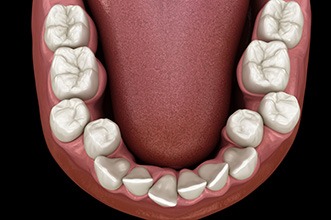
“Does Invisalign fix crowded teeth?” This is a very common question we get from parents, and we have good news: the answer is “yes!” If we determine that your child is a candidate for clear aligners, then we will use them to gently guide their teeth into their properly aligned positions, improving the look, health, and function of their smile in the process.
Gaps Between Teeth

Spaced-out teeth are similar to overlapping teeth in the sense that they create unique crevices where food particles and plaque can hide. Since this increases their risk of developing tooth decay, we strongly recommend scheduling a consultation for your child at our office sooner rather than later. If we decide together that Invisalign is the best option, then there’s a good chance that we can close the gaps in just 12-18 months.
Overbite

When your child bites down, do their upper teeth protrude beyond their lower ones significantly? If so, it’s important to bring them in. From there, we can determine if Invisalign can effectively align their bite. Often, this requires the use of other orthodontic accessories, like buttons and rubber bands, but you don’t have to worry – they are still considerably more discreet than traditional braces.
Underbite
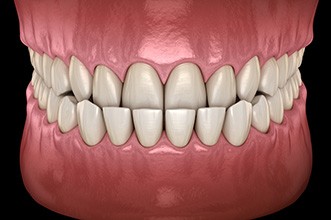
Underbites occur when the lower teeth sit in front of the upper ones. This bite problem can make it difficult to enunciate clearly, chew properly, and smile confidently, which is why we recommend exploring your child’s treatment options, even if their case is relatively mild. If they are a candidate for clear aligners, then we will create a custom series to guide their teeth and bite into their ideal positions.
Crossbite
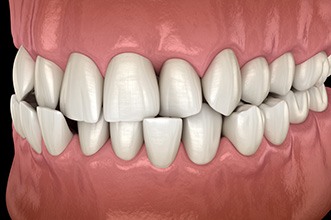
Like the other orthodontic problems on this list, crossbites can negatively impact your child’s self-esteem as well as their oral health, their chewing patterns, and their ability to enunciate clearly. Luckily, traditional braces are no longer the only solution; mild to moderate cases can usually be addressed with Invisalign. The best part? There aren’t any bulky brackets or protruding wires!
Open Bite

Is there a space between your child’s upper and lower teeth that prevents them from biting down all the way? Whether it’s due to prolonged thumb-sucking or genetics, we strongly recommend scheduling a consultation at our office so we can assess the severity of their case. Then, we can determine if Invisalign is an option.
Benefits of Invisalign

Hands down, the biggest draw of Invisalign is that the aligners are see-through, making orthodontic treatment more discreet than ever before. However, there are other benefits that are equally as noteworthy, even though they aren’t talked about as much. Here are a few:
Comfortable Trays
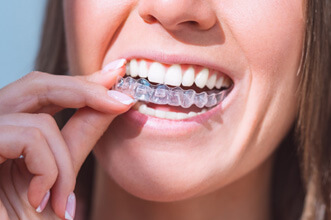
Conversations around Invisalign aligners are often centered around how clear they are. However, that’s just one perk; they are also quite comfortable! That’s because they are custom-made so they don’t dig into the soft tissue in your mouth. Plus, they are crafted from high-quality, low-profile, and smooth plastic, which ensures your tongue, lips, and gums won’t get irritated either.
Hassle-Free Oral Hygiene
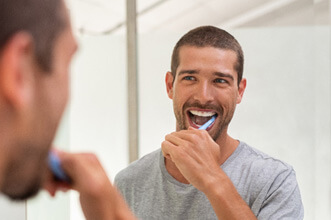
Since the brackets and wires can’t be removed, patients with traditional braces need to adapt to brushing and flossing around them. Usually, this requires the use of special oral hygiene products, like interproximal toothbrushes. That’s not the case with Invisalign. When you’re ready to complete your dental care regimen, all you need to do is take your aligners out first!
Fewer Check-In Visits

Although each treatment plan is unique, most patients with traditional braces need to come in monthly for adjustment appointments. As you can imagine, this isn’t ideal for busy students, parents, and professionals. The good news is that the Invisalign check-in visits are more spaced out; instead of every four weeks, they are every six weeks or so. That means less time in the treatment chair for you!
Shorter Average Treatment Timelines
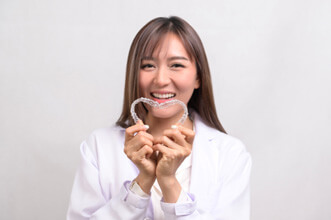
Ultimately, the length of your treatment plan will depend on factors unique to you, including how complex your case of malocclusion is. With that said, Invisalign does deliver quicker results on average. In fact, many patients work through their entire series of trays in just 12-18 months. So, if you want to have straight teeth as quickly (and safely) as possible, contact us to find out if you’re a candidate for Invisalign!
No Dietary Restrictions

Did you know that patients with traditional braces need to alter their diet to help prevent problems like broken brackets and loose wires? It’s true! Whole apples, cashews, celery, and popcorn are just a few of the foods on the list of dietary restrictions. If these are some of your favorite snacks, don’t worry – you don’t need to alter your diet with Invisalign.
Improved Confidence

One downside of traditional metal braces is that patients feel like they need to hide them when they smile or laugh. Clear aligners, on the other hand, blend in seamlessly with your teeth, ensuring no unwanted attention is drawn to your smile. Plus, the fact that they are clear and removable allows you to watch your teeth move closer and closer to their ideal positions!
Living with Invisalign Aligners

Now that you have a general idea of how Invisalign works and the benefits of this innovative orthodontic treatment, you might be wondering, “What does day-to-day life look like with clear aligners?” That’s a great question, and one we will answer in this next section! As always, if you want to learn more or you have a specific question regarding life with Invisalign, you’re welcome to give us a call too.
Wearing Your Trays

There is one simple, but important, rule: you need to wear your Invisalign aligners for 20-22 hours a day, every day. So, don’t get in the habit of taking them off for long periods of time. Instead, use a stopwatch to keep track of your aligner-free time, or set a reminder on your phone so you put them back on ASAP. This may seem excessive, but it will go a long way when it comes to meeting the wear time goal consistently.
Cleaning Your Aligners
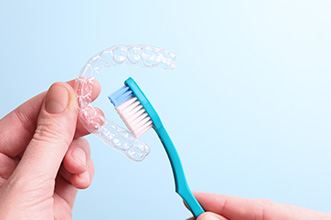
Fortunately, keeping your aligners clean is quick and easy. Simply rinse them with clean, cool water each time you take them off, and gently scrub them with a damp, soft-bristled toothbrush before putting them back on. You can also use a clear, mild dishwashing liquid, if needed, and soak them in a dentist-recommended cleaner each night to keep them odor-free. Just make sure not to use anything harsh, like mouthwash, regular toothpaste, or bleach.
Eating & Drinking

As you know, a huge perk of Invisalign is that there aren’t any dietary restrictions. That said, there are some things you need to keep in mind when it comes to eating and drinking. The first is that you need to take your aligners out (with the exception of water). The second is that your diet impacts your oral health. So, limit your intake of sugary and starchy foods. This will help prevent a cavity or another serious oral health problem from derailing your orthodontic treatment.
Damaging a Tray

You might be surprised to hear that you can continue to wear your aligners if there is a very small, hairline crack along the surface. Just make sure that you exercise the utmost care and, if the break gets worse, that you contact us ASAP. From there, we can determine if you can move onto the next set of aligners a bit early or if you should wear the previous pair while replacements are made.
Routine Check-Ins
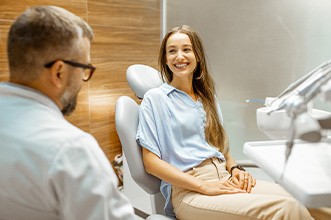
With Invisalign, you don’t have to come to our office every month for adjustment appointments. Instead, you will progress through a series of trays at home and come in every six or eight weeks. Each of these visits is crucial because they give us an opportunity to see how your teeth are responding to the aligners. If everything is on-track, then you should be in and out of the treatment chair in 20 minutes or less!
Understanding the Cost of Invisalign

Misconceptions about the cost of Invisalign stop many people from choosing clear aligners to fix their bite and alignment issues. You might be surprised to learn that Invisalign may cost about the same as traditional metal braces. You don't have to be rich to benefit from the clear choice in orthodontics. We have the solutions you need to keep a straight smile within your budget using Invisalign.
Factors That Affect the Cost of Invisalign
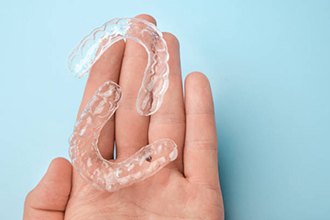
There isn't a flat fee for Invisalign because every mouth is unique. Various factors will influence the amount you'll pay, like:
- Consultation: You will require an initial consultation to ensure Invisalign can fix your misalignment issues. Although it can treat a variety of bite and alignment problems, Invisalign may not be right for everyone.
- Preparatory Treatments: You must have healthy teeth and gums before starting Invisalign treatment. It's not unusual to require a little prep work, like a dental cleaning or filling.
- The Number of Arches: Single arch treatment is possible, but it is rare. You can expect to need Invisalign for both the top and bottom teeth.
- The Complexity of Your Case: Complex tooth movements will require more aligners to resolve. Therefore, this can increase the cost of your treatment.
Invisalign vs. Mail-In Aligners: Which Costs More?
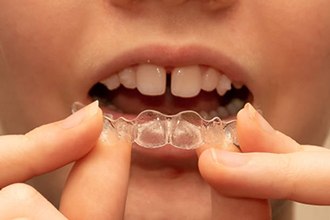
There are various DIY and mail-order orthodontic solutions, but they come with several risks. Since you're never under the supervision of a dentist, irreversible damage can occur, including tooth loss. It's best to skip the risks and invest in safe, proven results with the help of a cosmetic dentist. We will move your teeth with accuracy to improve the health, function, and appearance of your smile.
Does Dental Insurance Cover Invisalign?

Every dental insurance plan differs, but most policies can be used to lower the amount you'll pay for certain steps in your treatment, like your consultation or preparatory procedures. If your dental plan includes orthodontics, your insurance will pay a set amount after meeting your deductible. We will work on your behalf with your dental insurance to maximize your coverage to lower your out-of-pocket expenses.
Options for Making Invisalign Affordable

Our office offers various financial solutions to keep Invisalign affordable. Besides using your dental insurance, our office also accepts:
- Traditional Payments: We accept cash, personal checks, and most credit cards for payment.
- Financing: Based on your credit approval, you can benefit from little or no interest in financing. You can make monthly installments on your treatment plan, so your financial situation doesn't stand in the way of achieving your best smile.
Invisalign FAQs
Who is Not Eligible for Invisalign?
If your case of malocclusion is severe, then you won’t be a candidate for Invisalign – at least initially. That’s because traditional braces are required to address considerable overcrowding, overbites, and other common orthodontic problems. The good news is that some patients are candidates for hybrid treatments, which means that you could start your teeth-straightening journey with traditional braces and end with Invisalign. Ultimately, that’s something that you and Dr. Aieman Jazaierly will decide together. So, if you are interested in learning more about your orthodontic treatment options, don’t hesitate to schedule a consultation!
How Long Does Invisalign Take?
There is an average treatment timeline with Invisalign: 12-18 months. However, that range can be misleading for some. After all, if you don’t consistently wear your aligners for 20+ hours a day, treatment plan delays are inevitable. Conversely, mild cases of malocclusion may only take six months to correct.
Does Invisalign Hurt?
Invisalign doesn’t hurt. That said, it’s normal to experience some soreness as your teeth are guided into their ideal positions. If this happens, then stick to soft foods, sip on cool water, use cold compresses, and take OTC pain medication as directed.
What if My Invisalign Broke?
Let’s first discuss what you shouldn’t do, like attempting to repair your aligner with superglue or moving onto the next set in the series without consulting us. These can lead to serious consequences, including unwanted treatment plan delays, which is why we recommend instead contacting us ASAP to share what happened. From there, we can learn more about your situation, including how extensive the damage is, and determine the best way to proceed.
Can You Eat with Invisalign?
Since Invisalign aligners are removable, you don’t have to completely eliminate any foods from your diet! You do, however, need to be mindful of how what you eat impacts your oral health. After all, if you overindulge on candy or soda and develop a cavity, then your treatment plan will be put on hold until you get the necessary restorative care. Similarly, if you bite into something extremely crunchy, like a hard pretzel, and one of your attachments comes off, you need to come in right away so we can fix it.
How Do I Clean My Invisalign?
Typically, patients need just two things to keep their Invisalign aligners clean: cool water and a soft-bristled toothbrush. The key to preventing stains from surfacing, however, lies in your daily habits. In other words, it’s crucial that you use these products twice a day (or after each meal) consistently. It’s also a good idea to follow the other guidelines we give you, like not drinking coffee with your aligners on and rinsing them with clean, cool water each time you take them off.
